Will our plastic world collapse?
 Sunday, October 11, 2015 at 05:04AM
Sunday, October 11, 2015 at 05:04AM We’ve had plastics for more than a century. In that time we have identified an ever-expanding list of uses for them and a forever increasing number of different types (although not necessarily in that order). One of the most important practical characteristics of most plastics is that they last. Plastics are not easily damaged by water or air. Microorganisms do not commonly – or readily - break down plastics either and that is a problem.
From the myriad of common plastic items comes a tide of refuse. Shopping bags, food wrappers, drinking straws, soft drink bottles and cosmetic microbeads are distributed far and wide by people water and wind. CSIRO scientists recently concluded that by 2050 90% of sea birds will have plastic in their gut.
None us have never known a time without plastics, but a little over a hundred years is not even a blink of an eye in evolutionary time. Microorganisms simply have not had time (and perhaps reason) to evolve ways of breaking down the vast bulk of plastics. Microorganisms, however, reproduce quickly and there is more some evidence that things might be changing.
In 2011 marine biologists at the Woods Hole Oceanographic Institution in Massachusetts presented evidence of bacteria apparently eating away at the surface of plastic waste in Atlantic Ocean. A few years earlier, two secondary students (Daniel Burd and Tseng I-Ching) separately showed that some strains of bacteria can break down some common plastics, specifically polyethylene and polystyrene. Earlier this year scientists in China and US added more depth to this by showing that mealworms are quite happy consuming polystyrene – because of the bacteria in their guts.
Even as early as the 1970s, Japanese scientists identified bacteria that could break down nylon.
Scientists from Yale published a study in 2011 showing that some varieties of the fungus Pestalotiopsis microsporacan not only break down polyester polyurethane (PUR), but can actually live on it in anaerobic conditions and with the PUR as the only source of carbon.
All of this is very exciting when you think about being able to biodegrade all the immense volumes of plastic landfill we have accumulated, not to mention the masses of waste plastic that make their way into our oceans and waterways. Plastic waste debris. Image by CSIRO.
But . . .
If microorganisms that can break down plastic become widespread, especially if they are able to feed on a range of plastics, what happens next? Look around you. Plastics are used clothing, automotive parts, construction materials, electronic components. Buttons, contact lenses, electrical cable insulation, sunglasses, runners, dashboards, prosthetic limbs, flash drives, inflatable toys, plumbing pipes, credit cards, wet suits . . .
There is a rich supply of food for the microorganisms that develop the capacity to consume it. There is also the risk that in the act of biodegrading plastics, the microorganisms might release all manner of unpleasant or dangerous compounds.
It seems therefore that we need to learn as much as possible about such organisms, so that they can help us with our burgeoning waste problem, but also so that they don’t start eating the “wrong” things. Taken to a fairly extreme length, things would literally fall apart.
Plants get sick too
 Saturday, July 12, 2014 at 04:09AM
Saturday, July 12, 2014 at 04:09AM Like so many others, I spent a bit of time recently being ill. In between the sniffles, coughs, nausea and self-indulgence, I had time to think about immunity, but not just my own. I found myself musing about plant immunity. I mean they get sick too, right? 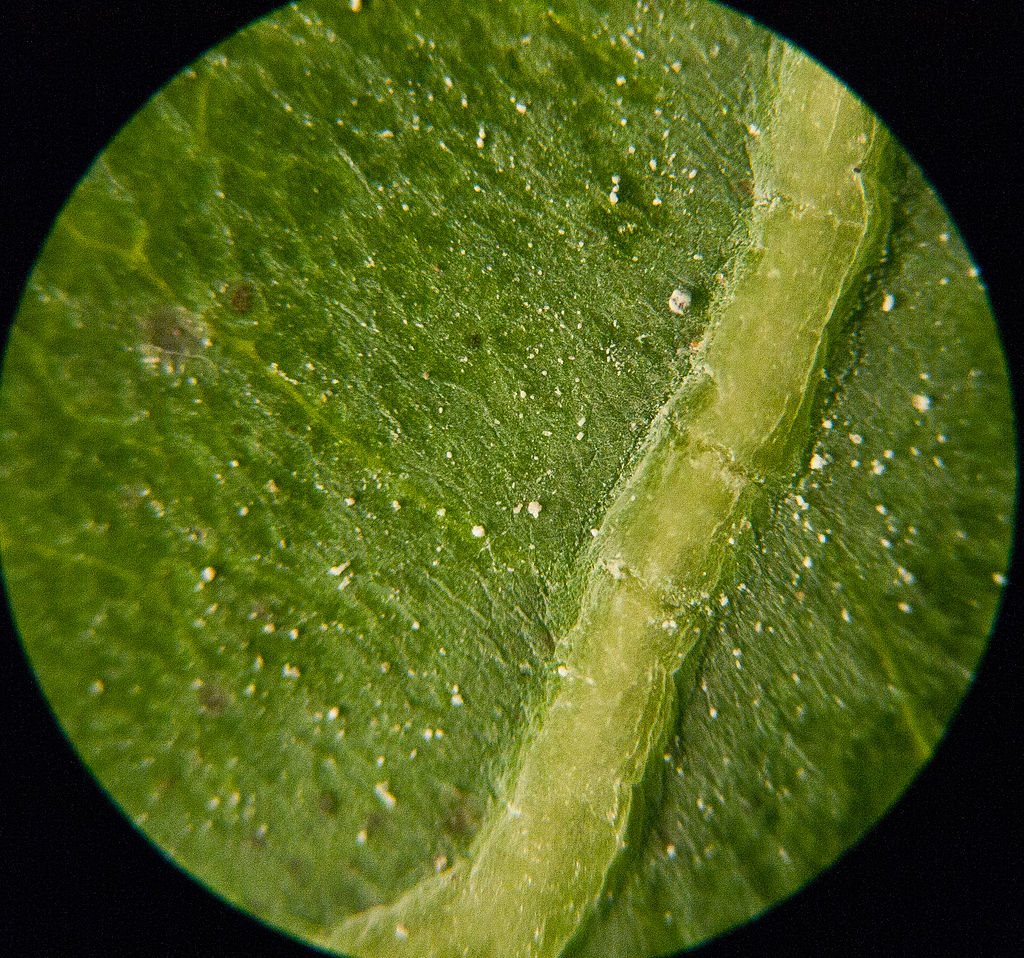 Image by Оля Марусин та Zlir'a (Own work (Власна робота)), via Wikimedia Commons Well yes they do and after some quick research I was surprised and impressed at the complexity and ingenuity of immunological response exhibited by those in the other living kingdom. Here’s a quick overview.
Image by Оля Марусин та Zlir'a (Own work (Власна робота)), via Wikimedia Commons Well yes they do and after some quick research I was surprised and impressed at the complexity and ingenuity of immunological response exhibited by those in the other living kingdom. Here’s a quick overview.
Plants, like humans (and other animals) can suffer from the actions of viruses, bacteria, fungi and parasites and, like us, they protect themselves with physical structures to minimise the chance that a predator or pathogen will cause serious damage. In humans, an example of this is the skin; in plants, the waxy cuticle often found on the surface of leaves. Most plant pathogens find their way into the plant via w wound or other opening, e.g: stomata. Vertebrates also have an adaptive component of their immune system that features specialised immune cells (lymphocytes) such as B cells and T cells. This adaptation allows vertebrates to “remember” a particular pathogen and so mount a very quick defence of they encounter it again in the future.
Plants do not have these sorts of immune cells, but that does not mean that their immune responses are any less impressive. On the contrary, plants exhibit a wide range of antimicrobial defences.
Plants and their pathogens have been evolving together for millions of years, so their relationships and their respective adaptations are complex. Pathogens come with baggage – biochemical baggage, known as pathogen-associated molecular patterns or PAMPs - and it this that plants need to be able to recognise. Examples of PAMPs include the proteins that make up the flagella of bacteria, lipopolysaccharides and peptidoglycans (which are found on the cell membrane of some bacteria) and chitin. Chitin is the main component of crustacean and insect body parts, as well as the cell walls of fungi.
If an organism made in part of chitin attacks a plant, the plant can produce chitinases, enzymes that can break down the chitin. That’s a very useful adaptation, but the story doesn’t end there. Many plant pathogens have evolved a response to this response. In such a situation, Cladosporium fulvum (a fungus) will, for example, secrete a lectin (a protein) that binds to the chitin in its cell walls, protecting it against the chitinases produced by the plant.
One of the most clever responses of plants to attack is the co-opt assistance from other organisms. When a tobacco hornworm caterpillar takes a bite from a tasty tobacco leaf, it triggers an emergency response from the tobacco plant. The tobacco plant releases green leaf volatiles (GLVs). These are the compounds that give freshly mowed grass its distinctive aroma. When the saliva of the hornworm caterpillar mixes with the GLVs released by the plant, they are changed, making them very effective at attracting predators, which then eat the herbivores that are consuming the plant. There are many other examples of this strategy throughout the plant kingdom.
In the case of a viral infection, the virus releases proteins known as effector proteins. These can be recognised by the plant’s resistance genes, or R genes. The response of R genes can trigger warning signals to be sent other part of the plant; they can even lead to changes in the local cell walls to prevent the virus spreading further. Plants can even be immunised against some diseases, by manipulating these R genes so their response lasts longer for more enduring protection.
Most plant pathogens feed on living plant tissue, so one way of limiting the spread of a pathogen is to isolate the area of attack and kill the surrounding cells. This is known as a hypersensitive response, and is basically selected cell suicide. One visible indication of this can be a patchy or mottled appearance of plant leaves.
 Image by Andrew PurdamDeep down I think I knew that once I started looking into plant immunity, I was going to be impressed, and I have been. I have barely scratched the surface (epidermis?), so if you want to know more, here are a few useful places to start.
Image by Andrew PurdamDeep down I think I knew that once I started looking into plant immunity, I was going to be impressed, and I have been. I have barely scratched the surface (epidermis?), so if you want to know more, here are a few useful places to start.
http://journal.frontiersin.org/Journal/10.3389/fpls.2014.00178/full
http://www.abc.net.au/science/articles/2012/06/12/3522493.htm
http://www.nature.com/nature/journal/v444/n7117/full/nature05286.html
Being your own Guinea Pig
 Saturday, November 9, 2013 at 05:58AM
Saturday, November 9, 2013 at 05:58AM 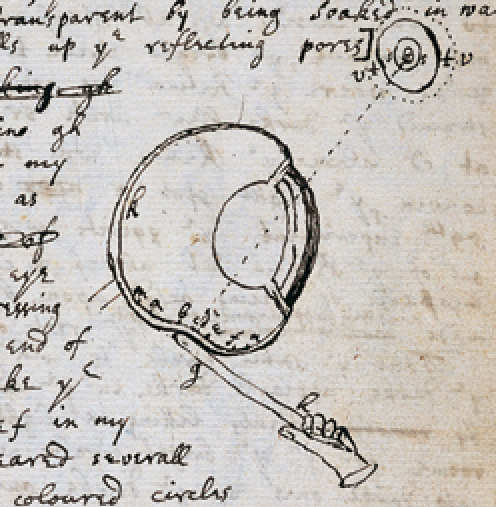 Science is a methodical approach to gathering knowledge. It is systematic and controlled, but don’t for a moment imagine that this means that basic curiosity is lost. Scientists are a very inquisitive lot. Throughout history there are examples of when they have turned to themselves for experimentation. Sometimes this has been through frustration, sometimes through impatience, sometimes to make a point. In any case there are some great (and at times disturbing) stories to tell. Here are 10 of my favourites.
Science is a methodical approach to gathering knowledge. It is systematic and controlled, but don’t for a moment imagine that this means that basic curiosity is lost. Scientists are a very inquisitive lot. Throughout history there are examples of when they have turned to themselves for experimentation. Sometimes this has been through frustration, sometimes through impatience, sometimes to make a point. In any case there are some great (and at times disturbing) stories to tell. Here are 10 of my favourites.
1. Black, yellow and totally disgusting
Stubbins Ffirth’s interest in yellow fever was prompted by an epidemic in his hometown of Pennsylvania when he was young. The outbreak saw the demise of 10% of the population. Ffirth was pretty confident that yellow fever could not be transmitted from human to human and as a medical student, set out to prove this. Yellow fever can be a particularly nasty disease. In the worst cases, bleeding in the mouth and gastrointestinal tract causes the sufferer's vomit to appear black and it was this blak vomit that Ffirth began working with.
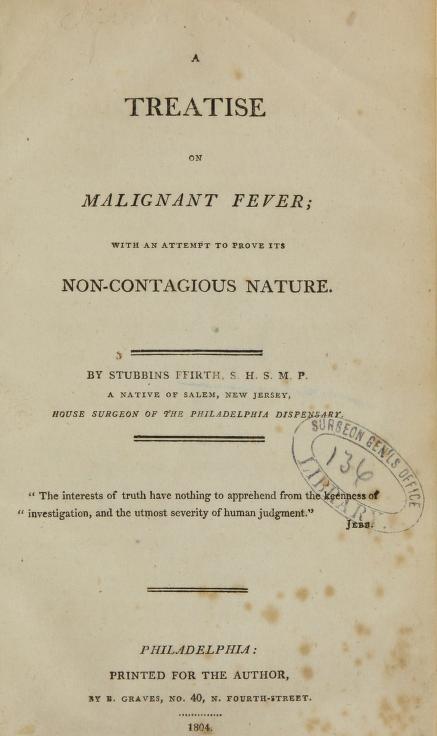 “I took [the vomit] internally from half an ounce to 2 ounces, drinking it without dilution . . . had the balk vomit been possessed of any active or deleterious property . . . how is it possible that I should never have the least effect produced?”
“I took [the vomit] internally from half an ounce to 2 ounces, drinking it without dilution . . . had the balk vomit been possessed of any active or deleterious property . . . how is it possible that I should never have the least effect produced?”
It's worth reading his thesis if only for the lovely turn of phrase. They don’t write theses like that any more.
As it happens, Ffirth was close, but not quite right. Decades later work by Carlos Finlay and then Jesse Lazear showed that yellow fever can be transmitted from human to human, but only when the disease is introduced directly into the bloodstream (it seems that Ffirths attempts to acheive this, were with old bodily fluids that were no longer able to carry the infection). Usually trasmisson is by mosquito. As an aside, Lazear had also been secretly testing the theory by having mosquitos bite him (although the one that carried the yellow fever that eventually killed him, might have been a wild mosquito).
2. Proving the safety of myxomatosis
In 1951, shortly after CSIRO released myomatosis to try to reduce feral rabbit populations, there was a coincidental outbreak of human encephalitis. With some poor media reporting (surprise), people started to link the two and something of a public panic began. In order to calm these erroneous fears and demonstrate that the myxoma virus held no disease risks for humans, Frank Fenner (great Australian virologist, who – among other things - played a vital role in the eradication of smallpox), Frank MacFarlane Burnett (virologist who was awarded a Nobel prize in 1960 for predicting acquired immune tolerance) and Ian Clunies Ross (parisitologist and then Chairman of CSIRO) did something impressive. In an act that today would lead every current affairs program, they injected themselves with enough myxoma virus to kill hundreds of rabbits. They were fine and their survival was triumphantly announced in Parliament by the Minster for Science.
3. Eyes of the beholders
Isaac Newton is one of the mot celebrated experimenters is history. He was a man of great curiosity and not even his own comfort would get in the way of that. At one point he carefully inserted long bodkin needle into his eye socket until it was deep enough for him to push and deform his eye ball. This was to try to better understand the way we perceive light and colour.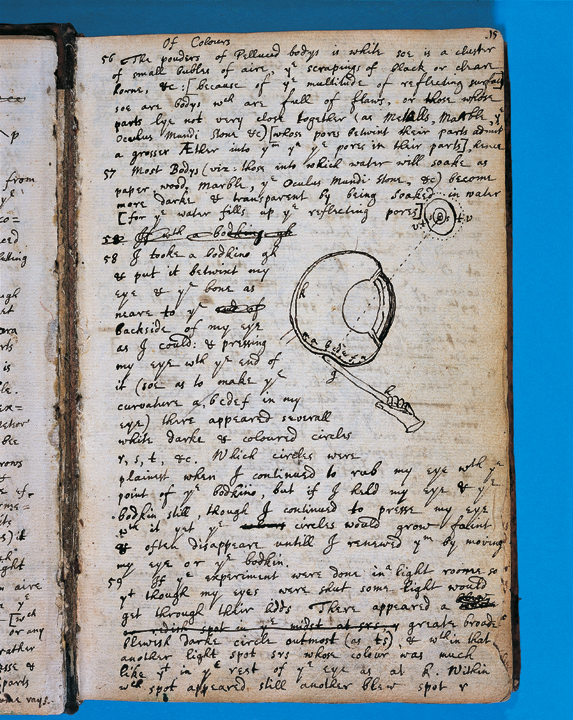
Decades later, Thomas Young undertook similar self-experimentation, to test whether the focusing ability of the human eye was achieved by a lens on the from of the eye or some change of the actual shape of the eye ball. Young inserted a hook down the side of his eye socket till it could rest against the back of his eye ball. He altered his focus, the hook did not move, indicating that there was no change to the shape of the eyeball. Young’s insights led him to become the first person to describe astigmatism.
4. Extreme daylight saving
Sleep is fascinating. Nathaniel Kleitman was interested in how hard wired our diurnal sleep patterns and circadian rhythms were, so in 1938 he and his assistant Bruce Richardson spent 28 days in a cave in pitch darkness to see of they could adapt to a 28-hour day. Kleitman struggled, but Richardson was successful.
5. Have a good trip.
Albert Hoffmann could have easily studied humanities or become an artist, but there was something alluring about discovering new things that drew him into chemistry. As a chemist at Sandoz in Basel (Switzerland) he was exploring pharmaceutical opportunities (what we'd probably call drug discovery today), mainly with regard to respiratory and circulation stimulants. During this work he was the first person to synthesize lysergic acid diethylamide, better known as LSD. One day he accidently absorbed some through his fingertips and experienced the first LSD trip. He described a “not unpleasant intoxicated-like condition, characterized by an extremely stimulated imagination . . . an uninterrupted stream of fantastic pictures, extraordinary shapes with intense, kaleidoscopic play of colours”. That was an accident, but three days later he deliberately took 250mg of LSD. As the effects started to kick in, Hoffmann got on his bike and rode home. Despite some slightly freaky experiences, Hoffmann continued to argue for the potential benefits of FSD as a treatment for various psychological conditions (and he lived to be 102).
6. I told you I was ill
Stomach ulcers can be very serious. They can cause very nasty internal bleeding and in extreme cases even death. For generations it was common knowledge that stomach ulcers (also known as peptic ulcers) were caused by stress. The only problem with his is that they aren’t. Stress can be an exacerbating factor, but in most cases, peptic ulcers are caused by bacteria. This was observed by Robin Warren a pathologist at Royal Perth hospital when he found patients whose stomachs were riddled with Helicobacter pylori. Warren began working with another doctor at the hospital, Barry Marshall. The two hypothesised that bacteria caused stomach ulcers, but it wasn’t easy to prove. They tried working with mice and pigs, but it turns out H. pylori only affects primates.
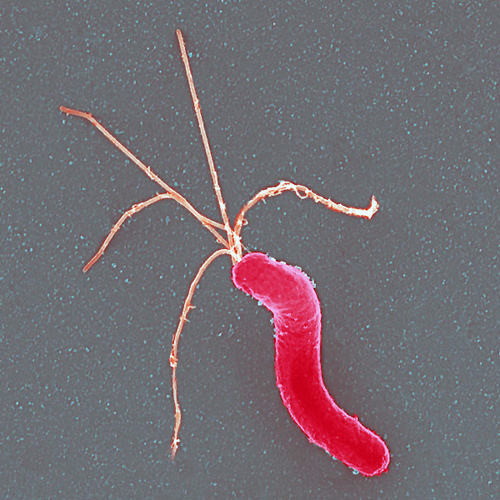 Helicobacter pylori, image by AJ Cann.They were not allowed to set up a proper human trial, so Marshall undertook a trial on himself. He ingested a petri dish of H. pylori, assuming it would lead to ulcers at some point. It did, and very quickly. Within a few days, Marshall had developed gastritis and pretty stinky breath. This was accompanied by nausea and lethargy. A biopsy revealed a happy colony of H. pylori. After a course of antibiotics, this cleared up. For this work, Marshall and Warren were awarded the 2005 Novel Prize for Physiology or Medicine. Our improved understanding of the processes involved in the development of peptic ulcers has led to a greatly improved treatment and also a much reduced incidence of stomach cancer (at least in the western world).
Helicobacter pylori, image by AJ Cann.They were not allowed to set up a proper human trial, so Marshall undertook a trial on himself. He ingested a petri dish of H. pylori, assuming it would lead to ulcers at some point. It did, and very quickly. Within a few days, Marshall had developed gastritis and pretty stinky breath. This was accompanied by nausea and lethargy. A biopsy revealed a happy colony of H. pylori. After a course of antibiotics, this cleared up. For this work, Marshall and Warren were awarded the 2005 Novel Prize for Physiology or Medicine. Our improved understanding of the processes involved in the development of peptic ulcers has led to a greatly improved treatment and also a much reduced incidence of stomach cancer (at least in the western world).
7. Santorio Santorio
In the early 17th century, Santorio Santorio (also known as Sanctorius Sanctorius and other similar names) was a physician and Chair of Theoretical Medicine at the University of Padua. At this time, the understanding of nature and medicine was based largely on a qualitative understanding of things – the essence of things. Medical treatments were often about restoring the balance of the natural “humors”.
Santorio (I hope it’s ok to use just one of his names) started investigating and describing things from a more mechanical approach, with a greater emphasis on measurement. Santorio set out to answer a classic child’s question – what happens to my food after I eat it? Observant kids note that what they eat appears to be rather more than what ends up in the toilet. Santorio set up a very large balance system with a chair at one end. Using this apparatus, he weighed his food intake and his weight after excretion. He did this for about thirty years. To explain the difference between what he ate and what he excreted, Santorio developed his theory of insensible perspiration. We now have a much better understanding of the metabolic and biochemical systems that are at play, but Santorio’s work helped move medical research in a much more evidence-based direction.
8. Do you hear something?
In 1993, Dr Robert Lopez, a New York vet, was treating a cat with a nasty infestation of mites. The cat’s owner’s daughter had also complained of being itchy. Lopez also heard that after treatment when the cat’s infestation was gone the girls itching also cease, and he wondered if ear mites could or would move from cats to humans. Apparently the next logical step was to insert some ear mites from a cat into his own ear. He actually did this on a few occasions and in a paper published in the Journal of the American Veterinary Medical Association, he describes how he heard scratching sounds that became louder as they days went by and the mites moved deeper into his ear canal. He suffered intense itching to the point where he was unable to sleep. In 2007 Lopez received an Ig Nobel Award for his research. I’ve been flinching and itching just writing this.
9. Charles Babbage
Another great thinker and experimenter, Babbage is credited with designing the first programmable computer (with programming by mathematician Ada Lovelace) – in 1822. The most advanced of these machines were not completely built during Babbage’s lifetime, but a reconstruction in 1991 (using Babbage’s original specifications and engineering available the time he designed the machine) worked perfectly well. It seems like Babbage might have been a pretty humourless chap (he headed up an anti hoop-rolling campaign and was vehemently opposed to music in the street, especially that of organ grinders), but he was another of these relentless experimenters. He’s in this list because at one point he was lowered into Mount Vesuvius and at another time, he was placed inside an oven and baked at nearly 130oC for several minutes apparently just to see what it would be like. He claimed not to have suffered any great discomfort.
10. Sleep tight . . .
And then there’s Johnny Fedora, who a few ears ago uploaded a video of him allowing roughly 1000 bed bugs to feast on his arm. Enjoy.
Hold a status update in your hand
 Friday, December 7, 2012 at 08:11PM
Friday, December 7, 2012 at 08:11PM  Image by Flughafen3D printing is well in its way to becoming commonplace, perhaps even ubiquitous. It is becoming cheaper and more accessible and it's inspiring great creativity. As people discover/develop more applications for 3D printing, it will soon join smart phones, flat screen TVs and antibiotics as a technology that is taken for granted – at least in the western world. In fact it will not be long before we start to depend upon 3D printing, so now is as good a time as any to take a quick look at where things are heading, and it’s already amazing.
Image by Flughafen3D printing is well in its way to becoming commonplace, perhaps even ubiquitous. It is becoming cheaper and more accessible and it's inspiring great creativity. As people discover/develop more applications for 3D printing, it will soon join smart phones, flat screen TVs and antibiotics as a technology that is taken for granted – at least in the western world. In fact it will not be long before we start to depend upon 3D printing, so now is as good a time as any to take a quick look at where things are heading, and it’s already amazing.
There are a few approaches to 3D printing. Currently most desktop 3D printers (and yes, that phrase still blows my mind a bit) draw a polymer filament into an extrusion nozzle. The nozzle is heated and the molten polymer is extruded in layers, the printer head moving in much the same way as a traditional inkjet printer. Layer after layer the object is printed, it cools and solidifies. This technique is known as extrusion deposition. An alternative is granular materials binding, in which a binder is added to a layer of powdered polymer. Once the binder has been added to one layer, a new layer of polymer powder is spread on top of the first one and process repeated layer by layer.
There are also systems that expose liquid polymer to a beam of light (usually a laser) that causes the surface of the liquid to solidify (at the points where the light reaches it). Once one layer is complete, the build platform (now holding the first solid layer of the object) drops slightly deeper into the liquid polymer and the light bean goes to work on a new layer above. This technique is even being used to print blood vessels. Check out this link.
It is also possible to print from multiple printer heads, each using a different polymer. In this way, you can use soluble polymer for support structures. These are dissolved after printing the make intricate moving parts. A few years ago I was given a 3D-printed shifter spanner that was made in this way. I don’t think it’s as strong as a traditional seel spanner, but it operates in exactly the same way. Dissolvable 3D printing also opens to door to biodegradable 3D printing.
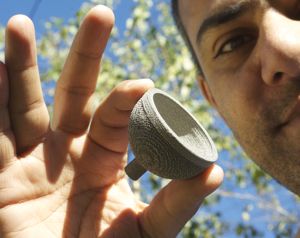 Me and a 3D printed titanium hip rotator cuff. Photo: Mary Vail.People are becoming familiar with 3D printing with plastics, but it doesn't stop there. I recently caught up with some very clever colleagues at CSIRO who showed me their 3D titanium printer. This uses granular materials binding produce 3D objects made of titanium. I tried moderate my excitement and keep the giggling and pointing to a minimum, but with only limited success.
Me and a 3D printed titanium hip rotator cuff. Photo: Mary Vail.People are becoming familiar with 3D printing with plastics, but it doesn't stop there. I recently caught up with some very clever colleagues at CSIRO who showed me their 3D titanium printer. This uses granular materials binding produce 3D objects made of titanium. I tried moderate my excitement and keep the giggling and pointing to a minimum, but with only limited success.
A layer of fine titanium powder is heated to partially set the powder, before an electron beam is used to fuse to powder. The object is built up layer by layer and excess powder is removed by sand blasting the object with more titanium powder. One application of this is replacement hip joints. Artificial hips have been around for many years, but as people get heavier and live longer, the strain on tradition artificial hips are starting to show and show sooner. Titanium hip replacements are stronger and lighter, and – because they are printed – can be designed for a specific patient’s body.
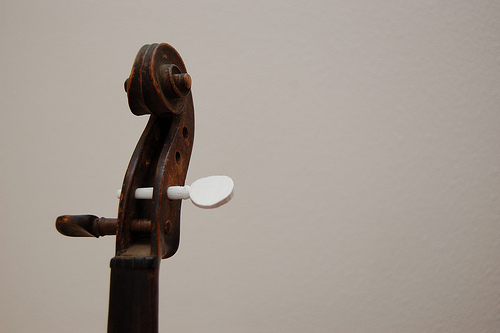 Replacement violin tuning peg. Image by MmassieWith access to single ingredient plastic 3D printing, biodegradable 3D printing and metal 3D printing, the range of possible applications is enormous. Personalised phone cases, kitchenware, repairs to damaged household appliances, toys and models, jewellery, car parts, light fittings, musical instruments, sporting equipment, Christmas decorations . . . Furthermore, people will be able to design and print their own objects in their own homes, and share their designs. This is a world where you can hold a Facebook update in your hand. But lets not stop there.
Replacement violin tuning peg. Image by MmassieWith access to single ingredient plastic 3D printing, biodegradable 3D printing and metal 3D printing, the range of possible applications is enormous. Personalised phone cases, kitchenware, repairs to damaged household appliances, toys and models, jewellery, car parts, light fittings, musical instruments, sporting equipment, Christmas decorations . . . Furthermore, people will be able to design and print their own objects in their own homes, and share their designs. This is a world where you can hold a Facebook update in your hand. But lets not stop there.
Surgeon Anthony Atala has outlined work to print with living cells, producing - for example - 3d printed kidneys and blood vessels. His TED talk is well worth watching.
Extrusion has been used in food processing for many years, that’s how they make Cheezels, fruit loops and macaroni. 3D printing will take this much further. Modern Meadow are working on 3D printed pork, among other things. So we’re apparently getting much closer to one of sci-fi’s favourite machines – the replicator.
As technology develops, our ability to translate thoughts and words to objects systems and environments becomes easier and faster. It took time for humans to gradually get used to being able to travel across the world in days and hours, rather than weeks and months. Printing new organs, cars, houses, toys and dinner will also take some adjustment, but we’re on our way.
 3D printing,
3D printing,  Atala,
Atala,  Modern Meadow,
Modern Meadow,  csiro,
csiro,  hip replacement,
hip replacement,  replicator,
replicator,  titanium
titanium Sensational soundscape
 Saturday, November 10, 2012 at 05:47AM
Saturday, November 10, 2012 at 05:47AM 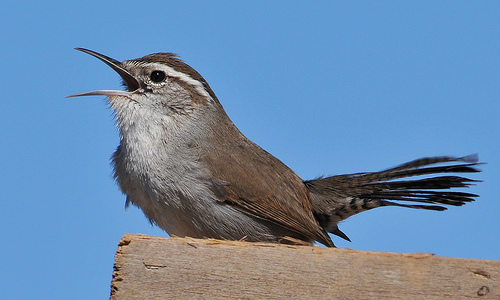 Photo by Matt KnothEvery now and then I like to sit very quietly and listen. With things to do and places to go, we tune out of most sounds most of the time, but the world is rarely – if ever – silent. Taking a few moments to listen and try to identify as many different sounds as possible is a very peaceful thing to do. It’s also fascinating and the other day it got me thinking. The animal kingdom is rich with sound, a glorious spectrum of tones and timbres. The range of animal sounds almost defies imagination, and the various techniques employed to produce these sounds is equally impressive.
Photo by Matt KnothEvery now and then I like to sit very quietly and listen. With things to do and places to go, we tune out of most sounds most of the time, but the world is rarely – if ever – silent. Taking a few moments to listen and try to identify as many different sounds as possible is a very peaceful thing to do. It’s also fascinating and the other day it got me thinking. The animal kingdom is rich with sound, a glorious spectrum of tones and timbres. The range of animal sounds almost defies imagination, and the various techniques employed to produce these sounds is equally impressive.
Humans (and many animals) produce vocal sounds with a larynx, an organ in the neck which is also involved in breathing and stopping food entering the windpipe. Basically we breath in and force this air across our vocal folds, which vibrate; this vibrates the air above the vocal folds producing a compression wave that we can hear. By adjusting the 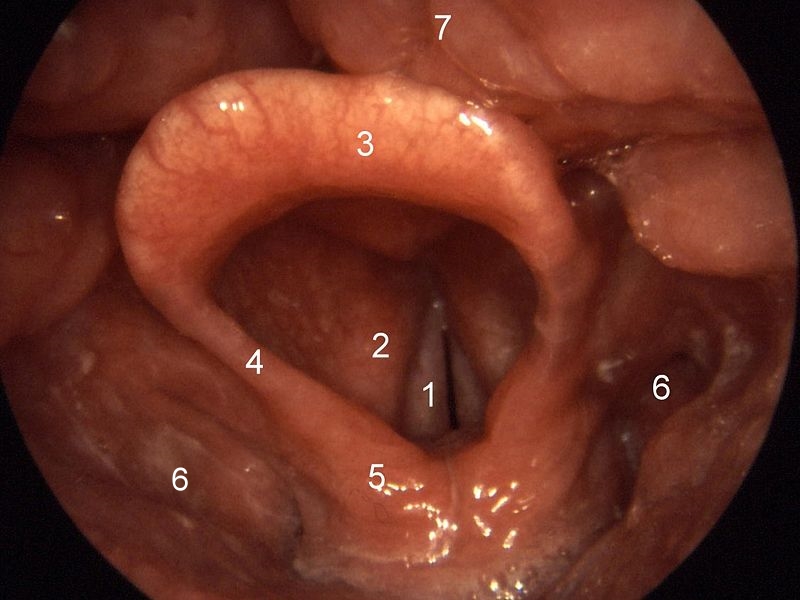 The vocal folds. 1=vocal chords, 2=vestibular fold, 3=epiglottis, 4=aryepiglottic folds, 5=arytenoid cartilage, 6=sinus piriformis, 7=base of the tongue. Photo by Welleschick.muscles around the vocal folds, as well as the throat and jaw, we are able to change the pitch and timbre of the sound. Our tongue, teeth and lips then conspire to add the consonant sounds that we use for speech.
The vocal folds. 1=vocal chords, 2=vestibular fold, 3=epiglottis, 4=aryepiglottic folds, 5=arytenoid cartilage, 6=sinus piriformis, 7=base of the tongue. Photo by Welleschick.muscles around the vocal folds, as well as the throat and jaw, we are able to change the pitch and timbre of the sound. Our tongue, teeth and lips then conspire to add the consonant sounds that we use for speech.
To breathe (without sound), we open our vocal folds; to whisper we open them enough to cause some turbulence in the air leaving our lungs, but no enough to vibrate the folds. This leads to the “hissing” nature of whispering. As you might expect, this is basically the same way that snakes make their characteristic hiss. Many snakes can make other sounds too – my father tells the story of walking through the Malayan jungle and being confronted by a large python that rose up off the ground and roared. A snakes larynx is positioned high in the head and can be extended out of the way as the snake swallows its prey.
Humans can display an unusual range of vocal sounds, but many other animals also maintain a repertoire of sounds primarily by adjusting the settings in their larynx. Compare the “rough” sound of a dog’s bark to it’s howl or growl.
 A happy cat. Photo by Yumi KimuraThe difference between a cat’s meow and it’s purr is a little different. For most cat noises, the familiar system of air moving from the lungs across the vocal folds is used. When purring, however, cats use a system called active muscle contraction. In this case the throat muscles are rapidly contracted to make the vocal cords vibrate.
A happy cat. Photo by Yumi KimuraThe difference between a cat’s meow and it’s purr is a little different. For most cat noises, the familiar system of air moving from the lungs across the vocal folds is used. When purring, however, cats use a system called active muscle contraction. In this case the throat muscles are rapidly contracted to make the vocal cords vibrate.
It had been argued that this was the same technique used by elephants to produce very low pitched sounds (these are usually inaudible to humans and are known as infrasounds). In August of this year, researchers from the University of Vienna showed that elephants are able to make these sounds in the same way they make other sounds (without using active muscle contraction). At the other end of he spectrum, bats make very high sounds that are also inaudible to humans, but essential for bat echolocation. Speaking of elephants you might have heard about Koshik, a Korean elephant who has learned to say some Korean words. The most impressive part of this is that normal elephant sounds are very different to human sounds, and Koshik needs to insert his trunk well into his mouth to make the sounds.
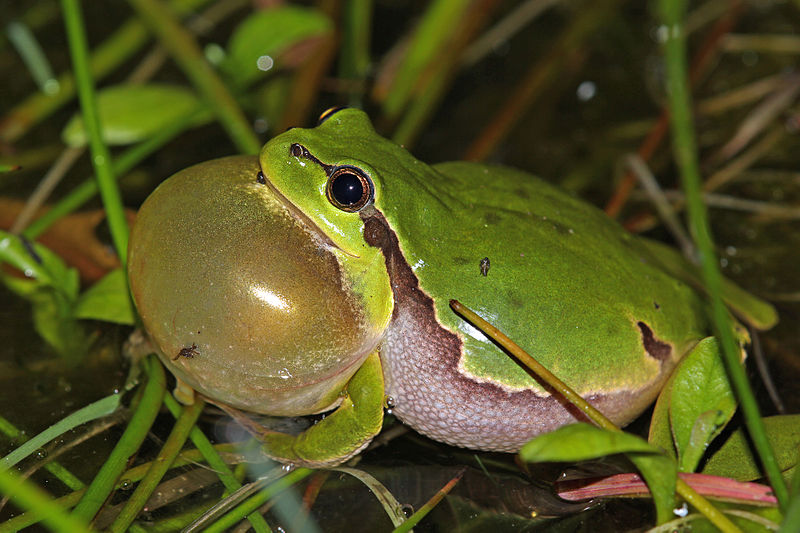 A frog and his vocal sac. Photo by Christian FischerFrogs can augment the sounds produced in their larynx with the use of a vocal air sac. The males of most frog species have air sacs. The frog inflates his vocal sac and makes a sounds using his larynx. The sound resonates in the inflated vocal sac, which makes the sound louder. As an interesting aside, frogs do not have ribs. Apart from making sounds, their larynx has a role to play as a sort of stop preventing their lungs collapsing during a dive, when there is increased pressure on the frog’s body.
A frog and his vocal sac. Photo by Christian FischerFrogs can augment the sounds produced in their larynx with the use of a vocal air sac. The males of most frog species have air sacs. The frog inflates his vocal sac and makes a sounds using his larynx. The sound resonates in the inflated vocal sac, which makes the sound louder. As an interesting aside, frogs do not have ribs. Apart from making sounds, their larynx has a role to play as a sort of stop preventing their lungs collapsing during a dive, when there is increased pressure on the frog’s body.
So far, the examples I’ve considered have been mammals, reptiles or amphibians.
I think birdsong is especially interesting and birds don’t make sounds in quite the same way. Bird sounds are made without a larynx or even vocal folds. The bird equivalent of a larynx is a syrinx. The syrinx is located at the base of the trachea, close to where the trachea separate into the 2 bronchi (which then conduct air between the 2 lungs). Air leaving the lungs vibrates membranes in the syrinx and birds have are able to exert muscular control over the syrinx in order to change the nature of the vibration and therefore the sound. What makes syrinx so interesting is that because is is located so close to where there are 2 bronchi, birds are able to make 2 different sounds simultaneously. This explains the complex - and I would say beautiful – nature of many bird songs. They can produce high and low sounds together or oscillate very quickly between such sounds. Consider the song of the Australian magpie or the butcherbird.
There are more examples on the Birds in Backyards website. And then there’s the astonishing mimicy skills of The fabulous lyrebird. Photo by Ryan Wick. the lyre bird. Check out this footage from David Attenborough’s ‘Life of Birds’.
The fabulous lyrebird. Photo by Ryan Wick. the lyre bird. Check out this footage from David Attenborough’s ‘Life of Birds’.
We send a lot our lives adding to the soundscape, so don’t forget to stop from time to time to listen to your fellow musicians.
